 Inexpensive measurement microphone with pre-amplifier for less than 17 € (all inclusive)
Inexpensive measurement microphone with pre-amplifier for less than 17 € (all inclusive)| DoppelWhopper | 2.5-way floor standing system for about 1000 €/pair (all inclusive) |
| Buschhorn | Contribution to the debate on back loaded horns (measurements of the "Buschhorn") |
| Measurement mic |  Inexpensive measurement microphone with pre-amplifier for less than 17 € (all inclusive) Inexpensive measurement microphone with pre-amplifier for less than 17 € (all inclusive) |

| Choice of the bass-midrange chassis: The bass-midrange chassis AUDAX HM170Z0 is used in famous loudspeakers like the BURMESTER 949 First (approx. 10000 €/pair, test in STEREOPLAY 05/98), the IQ 200/300 (3500/4500 €/pair, test in STEREOPLAY 11/94 or AUDIO 12/94) and showed good properties in the KLANG & TON comparison test of 17cm High-End bass-midrange chassis (see issue 06/93).
Choice of the tweeter: |
| Choice of bass chassis: Corresponding to the statements on the Tips for impatients page I've chosen a 2nd 17cm bass chassis for support of frequencies below 350 Hz. The bass-midrange chassis runs in parallel even to the lowest frequencies but shows only few excursion due to its 12 l closed box design. The bass chassis works in a 30 l bass reflex box. The frequency response of this type of low frequency design can be easily adjusted in a wide range by changing the Helmholtz frequency or even blocking the vent to harmonize with the frequency response of the reproduction room (see Tips for impatients). Due to its favorable Thiele/Small-parameters and its identical design the AUDAX HM170G0 was chosen as bass chassis. |
 |
Choice of chassis placement:
According to the flow diagram I first built test enclosures for all 3 chassis (incl. the tweeter), so even the placement of the bass-midrange chassis and the tweeter were variable. After several iterations (including time alignment and the development of specific dividing networks for each setup) a chassis placement with centrally mounted teeter and top mounted bass-midrange was found to give the best results with this set of chassis.
Choice of frequency dividing network design:
Due to some colorations of the bass-midrange chassis above 2.5 kHz the acoustical cutoff frequency was set at 2000 Hz. Because of thermal and mechanical reasons the tweeter must be high pass filtered with 18 dB/octave at 2200 Hz (electrical cutoff frequency). The bass-midrange is low pass filtered (slightly underdamped) at 1500 Hz (electrical cutoff frequency). Combined with the frequency response of the chassis themselves an acoustic 4th order Bessel characteristic with 2000 Hz cutoff frequency is achieved.
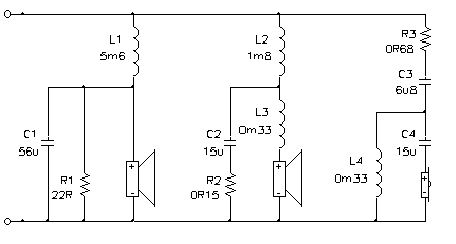
Some measurement results obtained with SB_OCT (without using the special test-CD):
Voltage across the individual speakers:

Total impedance:

Sound pressure level in listening room at 1m distance (BR open):

If you want to build the DoppelWhopper you'll find a detailed construction guide (German!) as PDF-file.
Further interesting speaker projects can be found on my link list.
My first impression of Peter's "pamphlet" was "shocking": this guy clears away the often heard and read (and finally believed) milestones of horn loudspeaker advantages like:
For mid and high frequency horns I agree with Peter's argumentation that the supposed higher efficiency is realized only by focusing the radiated energy on the main radiation axis. For public address applications this is a highly desired property. For HiFi applications often the total energy of the diffuse sound field is higher than the direct radiation. Therefore the off-axis radiation is much more important.
Even for optimum transformation of the radiation resistance 50% power efficiency cannot be exceeded which correspond to 109 dB/W/m for half space radiation. Horn loudspeakers that show a higher efficiency MAY ONLY achieve this by concentrating the energy on-axis. By definition they MUST radiated less off-axis (see K&T 3/98)!
It is very hard to extrapolate this thinking to the low frequency range. The dogma of omni-directionality in this frequency range is deeply embedded. For the usual diaphragm diameters of less then 30cm this is true below 200 Hz after all. However, the mouth of bass horns often have significantly higher equivalent diameters so that this frequency is shifted even lower. For the evaluation of the equivalent diameter not only the pure mouth area may be considered. If the mouth is adjacent to the floor and/or the wall these planes increase the effective horn length and thus produce a horn with bigger mouth area. Moreover the direct "reflection" of the mouth creates a virtually bigger mouth area (including the mirror images) with accordingly higher directivity.
But what is the benefit of this higher directivity? Especially in the low frequency region the sound field is very diffuse (due to missing absorption). This will cause the summation of sound radiation of all directions anyway (thus yielding the total radiated sound power), so what? But maybe this is the key to understand the effect of low frequency horns?
| As a single "Buschhorn" (so called according to it's creator Dr. med. A. Buschhorn, Göttingen) resided in my cellar room already for a while I spend an hour or so on one of these famous long winter evenings to do some quick measurements SB_OCT. With the Buschhorn there is a very obvious positive effect of the horn which I just wanted to document. The Buschhorn is a 2-folded back loaded horn mainly for small full range speakers like the VISATON FRS8 or the ACR FE83 with a coupling volume of 2.8 l and living room friendly dimensions (H=92cm, W=15.4cm, D=33cm). The horn constant of the Buschhorn is about 1.82 [1/m] yielding a horn cutoff frequency of about 49 Hz. The horn length is about 173cm (+ about 18cm mouth correction assuming free field radiation). Interpreted as a transmission line this would give resonances at 45 + n x 90 Hz. According to an article of D.B. Keele ("Low-Frequency Horn Design Using Thiele/Small Driver Parameter", presented on the 57th convention of the Audio Engineering Society, Los Angeles, May 1977, Preprint 1250) for the VISATON FRS8 within in Buschhorn the low pass effect of the coupling volume starts about 675 Hz, whereas the low pass effect of the moving mass starts already at about 180 Hz. Thanks to Dr. Buschhorn you may download a plan of the Buschhorn (87 kB PDF-file). |
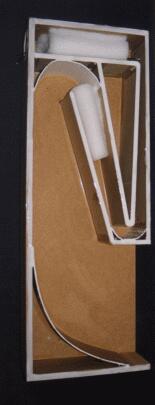 |
In order to document the behavior of the Buschhorn I've made the following measurements (each with open and closed horn mouth):
Impedance
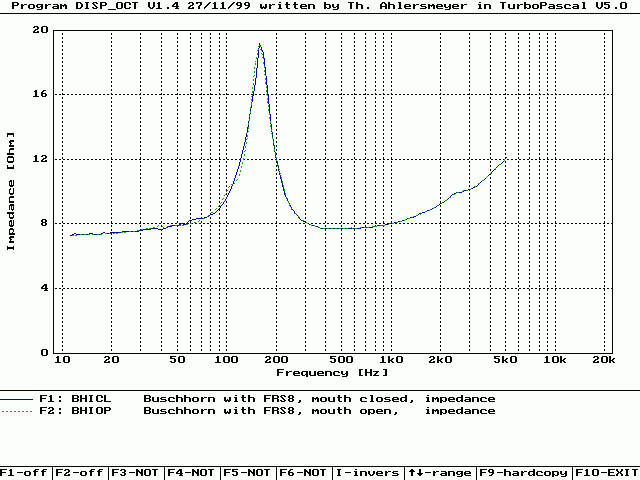
| Remark: | The Buschhorn stands upright on the floor (smallest distance to any wall > 1.5m) |
| Result: | From 80 to 120 Hz there is only a minor change with closed horn mouth (effect of horn?) |
Near field sound pressure level (10cm from speaker or horn mouth, respectively)
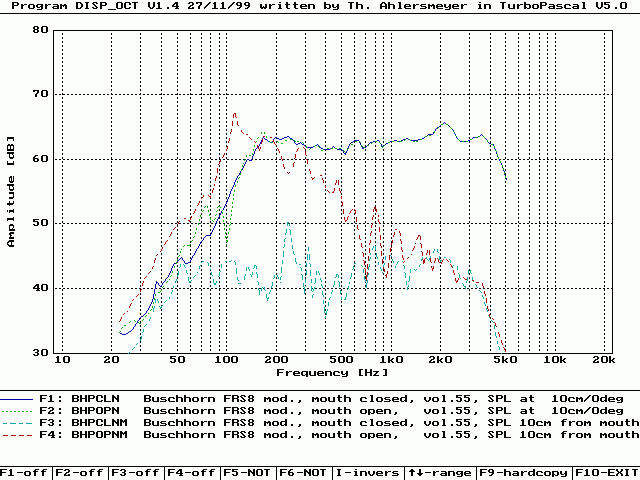
| Remark: | The Buschhorn stands upright on the floor (smallest distance to any wall > 1.5m) |
| Result: | Near to the speaker only between 60 to 110 Hz a minor change occurs (effect of horn?) Near to the horn mouth high radiation around 110 Hz and some minor peaks at 180 and 280 Hz are obvious. |
Sound pressure level in listening room (100cm, 0 degree from speaker)
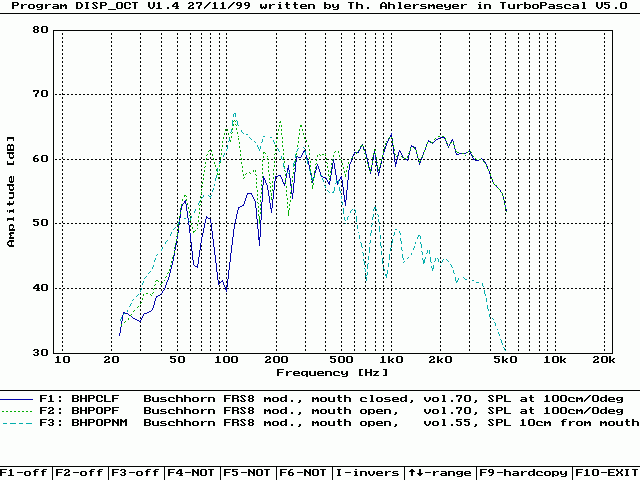
| Remark: | The Buschhorn stands upright on the floor (smallest distance to any wall > 1.5m) |
| Result: | Besides the main peak at 110 Hz minor peaks at 80, 100, 210 and 285 Hz come up in the room. This result is obviously heavily depending on the room itself and the exact positioning of the speaker inside the room. In general the decrease towards lower frequencies with closed horn mouth (approx. -5 dB/octave below 300 Hz) is changed to a slight increase (approx. 1 dB/octave) down to about 80 Hz (linearity +/- 4 dB)! The dip around 100 Hz with closed horn mouth is caused by reflections of the floor and a sideboard (detour about 170 cm each = half wavelength (180° phase shift) at 100 Hz)! As the horn mouth is located at the rear of the loudspeaker a higher directivity would cause less input to the microphone in front of the speaker. But as only the vertical dimension of the horn mouth is "big" the directivity is increased only in vertical direction. Horizontally the small mouth dimension has only a minor effect on directivity. By concentrating the energy vertically (thus not allowing so much energy to be radiated to the ceiling etc.) the high influence of the horn mouth at the microphone position might be explained. |
Sound pressure level in room (64 averages, minimum distance to speaker > 1.5m, height between 0.5 and 1.5m))

| Remark: | Die Buschhorn stands upright on the floor, 16cm from the rear wall and 80 cm from the side wall(room dimension: W=5m, D=4.5m, H=3m). |
| Results: | Due to the spatial averaging (good repeatability, see curves 1 and 2) the results look smoother. In principle they show the same results as above. As the horn mouth has a must better location to radiate low frequencies (amplification through floor, rear and side wall), the comparison with open (curves 1 and 2) and closed horn mouth (curve 3) is somewhat unfair. Therefore the Buschhorn with closed horn mouth was also measured "turned over" (standing n top, the speaker now radiating to the rear wall -> curve 4). But even in this position a lower spatially averaged sound pressure level was measured. This is even true when both results with closed horn mouth are summed up (curve 5)! Between 50 and 140 Hz the horn delivers a gain of at least 6 dB (even compared to the "turned over" speaker) and extends the low frequency range of the FRS8 by about one octave (from 140 Hz to 70 Hz). With more ideal placement and more effective usage of room resonances the 115 Hz peak might be reduced and the cutoff frequency lowered down to 60 or 50 Hz. |
Influence of the Buschhorn on speaker excursion
| Remark: | With sinusoidal excitation and clearly visible excursion the FRS8 was operated in free air and then pressed on the horn. The variation of the excursion was evaluated subjectively. |
| Result: | In the whole frequency range no obvious reduction of speaker excursion could be detected, except around 45 Hz (approx. Lambda/4- and horn cutoff frequency). |
Summary
Although the statements of Peter Krips originally were in contrast with my attitude most of them were confirmed by the measurement results on the Buschhorn. The 6 dB gain of the horn below 140 Hz might be caused by the higher directivity in vertical direction which concentrates the sound energy in the lower part of the room. Thus more energy reaches the microphone (and the listener) after a shorter time period (= less energy reduction).
Even the rumor of lower speaker excursion must be buried: with the same input voltage the same speaker excursion is created, with or without horn. Nevertheless the generated sound pressure level with horn and identical excursion is higher. Even the transmission line like behavior of a back loaded horn could be observed because of the reduced speaker excursion around the Lambda/4 frequency.
The measurement results including comments (German only) can be downloaded as a simple interactive presentation (the batch file Horn_Res.bat starts the presentation).

Although a lot of measurement programs are available in this field (e.g. SB_OCT) there is very few support on the microphone side.
Some kind of standard solution might be the proposal in KLANG & TON (Heft 05/1997) which is distributed by W. Fröhlich. For about 25 € you get a good microphone capsule, cables, plugs, switches, a small box etc. What a pity that a pre-amplifier was forgotten!
Why do you need a pre-amplifier? For that you have to know that normal microphone capsules have a typical output of about 5 mV/Pa. As 1 Pa corresponds to an already quite high sound pressure level of 94 dB (in 1m distance an ordinary 8 Ohm tweeter with 90 dB/W/m needs already 5 Volts input voltage or 3.2 Watt input power with sinusoidal excitation which is pretty near its thermal power handling capacity) you won't apply these levels without using ear protectors (which are mandatory in the production for a sound pressure level of 85 dB(A)!). This means that the microphone output signal during a loudspeaker measurement is often much less then 5 mV!
The microphone inputs of typical sound cards need in their most sensitive mixer setting about 10 mV (SoundBlaster® 16) to 50 mV (laptop) for full scale deflection! Unfortunately the microphone inputs of sound cards mostly show 2 important disadvantages:
The line input does not have these 2 problems but has some other disadvantages:

For these reasons one should only use the line input for serious measurements!
Therefore I've build up a measurement microphone with build-in pre-amplifier. As a basis I selected a tried-and-tested kit from CONRAD-Elektronik so that the building should not cause any problems (order numbers and prices from catalogue 2003  ) . Besides the components below you only need an aluminum tube (outer/inner diameter 12/10mm, length about 260mm).
) . Besides the components below you only need an aluminum tube (outer/inner diameter 12/10mm, length about 260mm).
| Naming (English) | Naming (German) | Order-Nr. | Price [€] |
| Pre-amplifier with condenser mic | Vorverstärker mit Kondensator-Mikrofon | 195375-77 | 7.95 |
| Elektrolytic condenser 22uF, 16V, RM5* | Elektrolyt-Kondensator 22uF, 16V, RM5* | 468240-77 | 0.18 |
| Resistor 100 Ohm, 1/4W* | Widerstand 100 Ohm, 1/4W* | 403130-77 | 0.10 |
| Softline box | Softline-Gehäuse | 523127-77 | 3.14 |
| Battery 9V | Batterie 9V | 650069-77 | 1.50 |
| Battery clip | Batterie-Clip | 624691-77 | 0.39 |
| Micro switch | Micro-Miniatur-Schalter | 708020-77 | 0.72 |
| Microphone cable 3m | Mikrofonkabel 3m | 606553-77 | 1.77 |
| 3.5mm stereo jack | 3.5mm-Klinkenstecker Stereo | 731480-77 | 1.20 |
| Summe | Sum | diverse | 16.95 |

Detail view of the opened pre-amplifier

| Microphone on stand | Microphone opened |
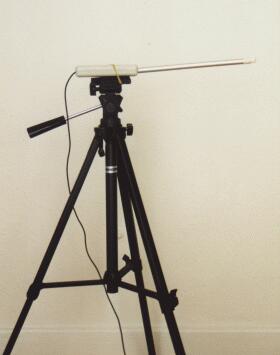 | 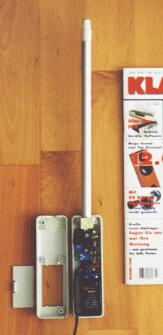 |
I've compared the so build microphone ("old" version, see above) with a professional BRÜEL & KJAER microphone Type 4188 (price about 1250 €). I've adjusted the internal amplification to give a sensitivity of about 1000 mV/Pa (which would correspond to 0 dB in the graphic below)! This allows to use the full dynamic range of the line input of sound cards with pink noise excitation of realistic levels in 1m distance (or at the listening location).

Although the frequency errors are slightly higher than for the K & T-proposal (5 dB peak versus 3 dB for K & T) the frequency range around the capsules resonance is less "wavy" (1/12th octave bands calculated out of narrow band data).

Finally I've compared the electrical behaviour of the "old" (MicPre2) versus the "new" (MicPre3) pre-amplifier (without capsule). Additionally the ELV-kit No. 17064 (rauscharmer Mikrofon-Vorverstärker) was tested (MicPre4). Although the later is by far the best choice electrically this kit doesn't fit into the softline box!

A measurement microphone using the "new" pre-amplifier (with above modifications) will show the following frequency response (calculated):

For those who don't like soldering there is a recommendation, too. The microphone pre-amplifier MPA-102 and the microphone ECM-40 (both from MONACOR, both together as an offer for 145 € at Audio-Z). However, the microphone shows a distinct increase at the upper frequency range:

REMARK:
In all cases only the nominal (not individual) frequency response of the reference microphone was used!